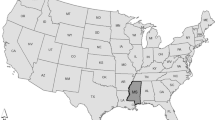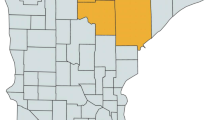Abstract
Forest conservation buffers provide ecosystem services such as soil and water conservation, wildlife habitat, and clean air. This research studied the experiences and intentions of participants in forest buffer contract programs in Virginia, USA provided by governmental conservation agencies. These programs offer technical assistance and share costs of establishment and maintenance for a period of time typically between 2 and 15 years. Program participant reflections about their experience and intention to retain their forest buffer after their cost-share contract ends were measured. Two-hundred and fifty-one program participants received a mail survey and 136 were returned (response rate = 54%). Two-step cluster analysis grouped respondents into four participant types based on responses to questions about buffer maintenance and costs, and perceived environmental benefits. Discontented and Doubtful respondents (23.4%) experienced financial and maintenance challenges. They also were doubtful about environmental benefits. Contented and Confident respondents (28.2%) experienced minimal financial and maintenance difficulties, and were confident that their buffers provide environmental benefits. Benefited with Burden respondents (22.6%) also were confident about environmental benefits, but experienced burdensome maintenance and costs. Skeptical without Strife respondents (25.8%) were not convinced their buffers provide environmental benefits, but have not had problems with maintenance or costs. A Kruskal–Wallis non-parametric test (α = 0.05) indicated that Discontented and Doubtful respondents are least likely to retain their buffer after their cost-share contract expires (rank sum = 42.2) and Contented and Confident are most likely (rank sum = 82.8). Benefited with Burden and Skeptical without Strife respondents (rank sum = 59.7 and = 59.8, respectively) were statistically similar to their Discontented and Doubtful counterparts, but slightly more likely to keep their buffer after their contract expires. Overall, Discontented and Doubtful and Benefited with Burden respondents had larger parcels of land and represented the largest percentage of full-time farmers, whereas Contented and Confident and Skeptical without Strife respondents had smaller parcels and were most likely to be part-time farmers or female. Findings suggest distinctions between types are clear along the onus of management, not necessarily perspectives on conservation. The two most influential drivers of program participation were cost-share assistance and water quality, whereas their most important management objective was improving land health.


Similar content being viewed by others
References
Allen JA, Keeland BD, Stanturf JA, Clewell AF, Kennedy HE (2001) A guide to bottomland hardwood restoration. Joint publication of the U.S. Department of Interior Geological Survey (Information and Technology Report USGS/BRD/ITR-2000-0011 and U.S. Department of Agriculture Forest Service General Technical Report SRS-40
Arbuckle JG, Valdivia C, Raedeke A, Green J, Rikoon JS (2009) Non-operator landowner interest in agroforestry practices in two Missouri watersheds. Agrofor Syst 75:73–82
Armstrong A, Stedman RC (2012) Landowner willingness to implement riparian buffers in transitioning watersheds. Landsc Urban Plan 105:211–220
Armstrong A, Ling E, Stedman R, Kleinman P (2011) Adoption of the Conservation Reserve Enhancement Program in the New York City watershed: the role of farmer attitudes. J Soil Water Conserv 66:337–344
Barbieri C, Valdivia C (2010) Recreational multifunctionality and its implications for agroforestry diffusion. Agrofor Syst 79:5–18
Beatty PC, Willis GB (2007) The practice of cognitive interviewing. Public Opin Quart 71:287–311
Bentrup G (2008) Conservation buffers: design guidelines for buffers, corridors, and greenways. General Technical Reports SRS-109. Department of Agriculture, Forest Service, Southern Research Station, Asheville
Boyer TA, Tong B, Sanders LD (2018) Soil and water conservation method adoption in a highly erosive watershed: the case of Southwest Oklahoma's Fort Cobb watershed. J Environ Plan Manag 61:1828–1849
Brinckman MD, Munsell JF (2012) Disproportionality, social marketing, and biomass availability: a case study of Virginia and North Carolina family forests. South J Appl For 36:85–91
Buttel FH, Gillespie GW Jr, Larson GW III, Harris CK (1981) The social bases of agrarian environmentalism: a comparative analysis of New York and Michigan farm operators. Rural Soc 46:391–410
Carr S, Tait J (1991) Differences in the attitudes of farmers and conservationists and their implications. J Environ Manag 32:281–294
Dillman DA, Smyth JD, Christian LM (2009) Internet, mail and mixed-model surveys: the tailored design method, 3rd edn. Wiley, Hoboken
Farmer JR, Ma Z, Drescher M, Knackmuhs E, Dickinson SL (2016) Private landowners, voluntary conservation programs, and implementation of conservation friendly land management practices. Conserv Lett 10:58–66
Featherstone AM, Goodwin BK (1993) Factors influencing a farmer’s decision to invest in long-term conservation improvements. Land Econ 69:67–81
Forshay KJ, Morzaria-Luna HN, Hale B, Predick K (2005) Landowner satisfaction with the wetlands reserve program in Wisconsin. Environ Manag 36:248–257
Gold MA, Garrett HE (2009) Agroforestry nomenclature, concepts, and practices. In: Garrett HE (ed) North American agroforestry: an integrated science and practice. American Society of Agronomy, Madison, pp 1–23
Groves RM, Dillman DA, Eltinge JL, Little RJA (2002) Survey nonresponse. Wiley, New York
Hagan PT (1996) Evaluating determinants of participation in voluntary riparian buffer programs: a case study of Maryland’s buffer incentive program. Master’s thesis. University of Maryland
Kassam A, Derpsch R, Friedrich T (2014) Global achievements in soil and water conservation: the case of conservation agriculture. Int Soil Water Conserv Res 1:5–13
Kassam A, Friedrich T, Derpsch R (2019) Global spread of conservation agriculture. Int J Environ Stud 76:29–51
Kenwick RA, Shammin MR, Sullivan WC (2009) Preferences for riparian buffers. Landsc Urban Plan 91:88–96
Kleiman DG, Reading RP, Miller BJ, Clark TW, Scott JM, Robinson J, Wallace RL, Cabin RJ, Felleman F (2000) Improving the evaluation of conservation programs. Conserv Biol 14:356–365
Knipps ACS (2011) Evaluation of the landowners incentive program in Texas: 1997–2007. Texas A&M University Dissertation. ProQuest Dissertations Publishing
Kruskal W, Wallis WA (1952) Use of ranks in one-criterion variance analysis. J Am Stat Assoc 47:583–621
Liu T, Bruins RJF, Heberling MT (2018) Factors influencing farmers’ adoption of best management practices: a review and synthesis. Sustainability 10:1–26
Lowell ST, Sullivan WC (2006) Environmental benefited of conservation buffers in the United States: evidence, promise, and open questions. Agric Environ Ecosyst 112:240–260
Matthews S, Pease SM, Gordon AM, Williams PA (1993) Landowner perceptions and the adoption of agroforestry practices in southern Ontario, Canada. Agrofor Syst 21:159–168
Munsell JF, Germain RH, Bevilacqua E, Schuster RM (2006) Voluntary best management practice implementation by nonindustrial private forestland owners in New York City’s water supply system. N. J. Appl For 23:133–140
Munsell JF, Addlestone BJ, Bukowski CJ, Nkembi L, Kingsly N, Moore EA (2018) Relationships between agroforestry and community development according to practitioners. Agrofor Syst 92:1387–1396
Napier TL, Tucker M, McCarter S (2000) Adoption of conservation production systems in three Midwest watersheds. J Soil Water Conserv 55:123–134
Pattanayak SK, Mercer DE, Sills E, Yang J (2003) Taking stock of agroforestry adoption studies. Agrofor Syst 57:173–186
Pfrimmer J, Gigliotti L, Stafford J, Schumann D, Bertrand K (2017) Motivations for enrollment into the conservation reserve enhancement program in the James River Basin of South Dakota. Hum Dimen Wild 22:382–389
Primdahl J (1999) Agricultural landscapes as places of production and for living in: owner’s versus producer’s decision making and the implications for planning. Landsc Urban Plan 46:143–150
Raedeke AH, Green JJ, Hodge SS, Valdivia C (2003) Farmers, the practice of farming and the future of agroforestry: an application of Bourdieu’s concepts of field and habitus. Rural Soc 68:64–86
Rilla E, Sokolow AD, Kozloff R, Lemp C (2000) California farmers and conservation easements: motivations, experiences, and perceptions in three counties. Research Paper #4. University of California Agricultural Issues Center, Davis
Robles-Diaz-de-Leon LF (1998) Evaluation of potential gross income from non-timber products in a model riparian forest for the Chesapeake Bay watershed. Agrofor Syst 44:215–225
Robles-Diaz-de-Leon LF, Nava-Tudela A (1998) Playing with Asimina triloba (pawpaw): a species to consider when enhancing riparian forest buffer systems with non-timber products. Ecol Model 12:169–193
Rossi FJ, Carter DR, Alavalapati JRR, Nowak JT (2010) Forest landowner participation in state-administered southern pine beetle cost-share programs. South J Appl For 34:3
Ryan RL (1998) Local perceptions and values for a Midwestern river corridor. Landsc Urban Plan 42:225–237
Ryan RL, Erickson DL, DeYoung R (2003) Farmers' motivations for adoption conservation practices along riparian zones in a mid-western agricultural watershed. J Environ Plan Manag 46:19–37
Schrader CC (1995) Rural greenway planning: the role of streamland perception in landowner acceptance of land management strategies. Landsc Urban Plan 33:375–390
Skelton P, Josaih SJ, King JW, Brandle JR, Helmers GA, Francis CA (2005) Adoption of riparian forest buffers on private lands in Nebraska, USA. Small Scale For Econ Manage Policy 4:185–204
Steven DD, Lowrance R (2011) Agricultural conservation practices and wetland ecosystem services in the wetland-rich Piedmont-Coastal Plain region. Ecol Appl 21:3–17
Strong NA, Jacobson MG (2005) Assessing agroforestry adoption potential utilizing market segmentation: a case study in Pennsylvania. Small Scale For Econom Manage Policy 4:215–228
Tkaczynski A (2017) Segmentation using two-step cluster analysis. In: Dietrich T, Rundle-Thiele S, Kubacki K (eds) Segmentation in social marketing. Springer, Singapore
Trozzo K, Munsell JF, Chamberlain JL, Aust WM (2014a) Potential adoption of agroforestry riparian buffers based on landowner and streamside characteristics. J Soil Water Qual 69:140–150
Trozzo K, Munsell JF, Chamberlain JL (2014b) Landowner interest in multifunctional agroforestry riparian buffers. Agrofor Syst 8:619–629
Udawatta PU, Garret HE, Kallenbach R (2010) Agroforestry buffers for nonpoint source pollution reductions from agricultural watersheds. J Environ Qual 40:800–806
USDA Economic Research Service (2009) 2007 Census of Agriculture. United States summary and state data, vol 1. Geographic area series. Part 51. AC-07-A-51
USDA Farm Service Agency (2012) Conservation reserve program annual summary and enrollment statistics. https://www.fsa.usda.gov/Assets/USDA-FSA-Public/usdafiles/Conservation/PDF/summary12.pdf. Accessed 3 Feb 2020
USDA Farm Service Agency (2015) Perspective participants/general public. https://www.fsa.usda.gov/programs-and-services/conservation-programs/prospective-participants/index. Accessed 27 May 2015
USDA Farm Service Agency (2017) Conservation programs. https://www.fsa.usda.gov/programs-and-services/conservation-programs/index. Accessed 28 Mar 2017
Valdivia C, Poulos C (2009) Factors affecting farm operators' interest in incorporating riparian buffers and forest farming practices in northeast and southeast Missouri. Agrofor Syst 75:61–71
VanBrakle JD, Germain RH, Munsell JF, Stehman SV (2013) Do forest management plans increase BMP implementation on family forests? A formative evaluation in New York City's watershed. J For 11:108–114
Vandever MW, Allen AW, Sexton NR (2002) Selected effects of the Conservation Reserve Program on program participants: a report to survey respondents. U.S. Geological Survey, Fort Collins Science Center, CO: Open File Report 02-476
Weller DE, Baker ME, Jordan TE (2011) Effects of riparian buffers on nitrate concentrations in watershed discharge: new models and management implications. Ecol Appl 21:1679–1695
Wigginton CD (2009) Evaluation of cost-share assistance programs as an incentive for wildlife habitat management and conservation on private lands in Mississippi. Mississippi State University, ProQuest Dissertations Publishing, Mississippi State
Willis GB (1999) Cognitive interviewing: a “how to” guide. https://www.hkr.se/pagefiles/35002/gordonwillis. Accessed 17 June 2015
Author information
Authors and Affiliations
Corresponding author
Additional information
Publisher's Note
Springer Nature remains neutral with regard to jurisdictional claims in published maps and institutional affiliations.
Rights and permissions
About this article
Cite this article
Commender, K.E., Munsell, J.F., Ares, A. et al. The Effects of Cost-Share Participant Experience on Forest Buffer Retention. Small-scale Forestry 19, 253–273 (2020). https://doi.org/10.1007/s11842-020-09435-8
Accepted:
Published:
Issue Date:
DOI: https://doi.org/10.1007/s11842-020-09435-8




